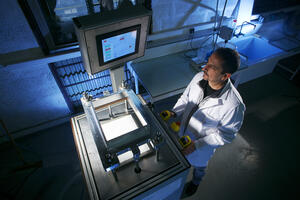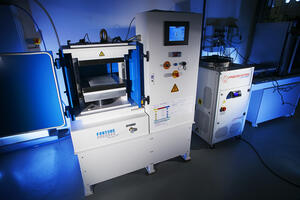
Services
Testing Laboratory
Producing wet-laminated sheets using MFCs
Moving towards all-cellulose packaging materials
- Develop the barrier properties of a paper/board by MFC deposit
- Produce A4 sheets
- Evaluate performance depending on the MFC grade
- Characterise barrier properties
General informations
Wet lamination of microfibrillated cellulose (MFC) is a unique process developed and patented by the CTP enabling a thin layer of MFC to be applied without glue to papers or boards in order to give them barrier properties and increase their stiffness, while preserving paper biodegradability and recyclability.This process provides a means of forming an all-cellulose barrier packaging.
The CTP’s laboratory facilities can be used to produce samples in A4 format in order to deliver proofs of concept and validate the approach taken and the performance levels obtained.
Thin MFC films can be laminated on different types of paper and board with different grammages and compositions.
Technical Data and Achievements
Laboratory equipment for wet lamination of MFCs
The laboratory-scale equipment can be used to laminate A4 sheets with MFCs in 3 stages:
- Filtering and suspension of MFCs through a membrane to form the wet MFC film. This is a conventional filtering process used in the paper-making industry.
- Replication of the MFC film on the paper/board substrate followed by pressing using a platen press.
- Drying on a flat dryer.
Evaluation of substrates and MFCs
Before the wet lamination stage, the CTP’s teams can evaluate the properties of the paper/board substrates and the MFC suspensions. The substrates and the MFCs can be supplied by the CTP.
Preparation/post-treatment of substrates
The CTP’s teams can prepare the substrates beforehand (precoating, plasma activation, calendering) or apply an additional surface treatment (coating, chromatogeny).
Evaluation of the materials formed
- Barrier properties
* Oxygen barrier: Oxygen transmission rate (OTR) in variable climatic conditions according to ASTM D3985, ASTM F1927 and ASTM F2714.
* Grease barrier: Oil absorbency of the material using the Cobb method according to SCAN-P37, Kit test according to ISO 16532-2, tests using palm kernel oil (ISO 16532-1) and turpentine (ISO 16532-3).
* Contaminant barrier. - MFC layer adhesion
The delamination strength of the MFC layer on the paper/board can be evaluated using peel methods at 180 or 90° according to various standards. - Other mechanical properties.
- Recyclability/biodegradability.
The material can be used to produce MFC films.
 |
 |
|
Also to be seen
Centre of Excellence